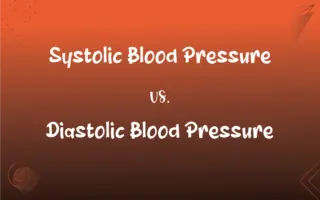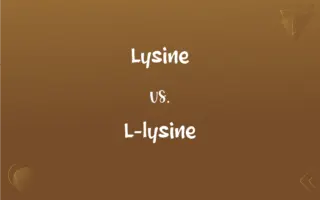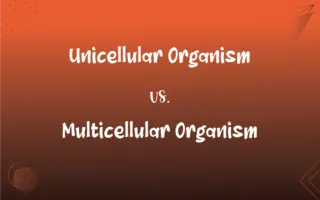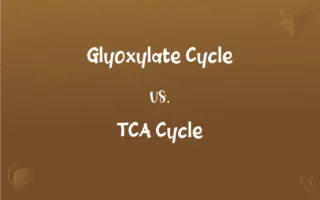Bone vs. Cartilage: What's the Difference?
Edited by Janet White || By Harlon Moss || Updated on October 18, 2023
Bone is a hard, dense connective tissue; cartilage is a flexible, semi-rigid connective tissue.

Key Differences
Bone is a rigid tissue that makes up the skeletal system, providing structure and support to the body. It also plays a role in mineral storage and blood cell production. Cartilage, on the other hand, is a resilient and smooth elastic tissue that performs various roles, including cushioning joints and providing structure to certain parts of the body, like the ears and nose.
While bones are vascular, meaning they have a blood supply, cartilage is avascular, meaning it doesn't. This characteristic affects how these tissues repair themselves; bones can heal relatively quickly, but cartilage has a limited capacity for self-repair.
Bones are primarily composed of collagen, a protein that provides a soft framework, and calcium phosphate, a mineral that adds strength and hardens the framework. In contrast, cartilage is mainly made up of chondrocytes, cells that produce a special matrix of collagen fibers and elastin fibers, giving it its unique properties.
A significant function of cartilage is to reduce friction and act as a cushion between joints. Bones, meanwhile, provide a framework for the body, facilitate movement, and protect vital organs.
In development, many skeletal structures start as cartilage and are later replaced by bone in a process called ossification. This shows the interconnected relationship between bones and cartilage in the body's growth and maintenance.
ADVERTISEMENT
Comparison Chart
Tissue Type
Hard, dense connective tissue.
Flexible, semi-rigid connective tissue.
Composition
Collagen and calcium phosphate.
Chondrocytes, collagen, and elastin fibers.
Blood Supply
Vascular (has blood supply).
Avascular (lacks blood supply).
Primary Function
Support, protection, movement facilitation.
Cushioning, reducing friction, structural support.
Repair Capacity
Relatively high.
Limited.
ADVERTISEMENT
Bone and Cartilage Definitions
Bone
Bone serves as a framework for body structures.
Bones provide support for our muscles.
Cartilage
Cartilage is a flexible, semi-rigid form of connective tissue.
The nose is primarily made of cartilage.
Bone
Bone is a dense, hard connective tissue forming the skeleton.
The femur is the longest bone in the human body.
Cartilage
Cartilage offers structural support to some body parts.
Sharks have skeletons made entirely of cartilage.
Bone
Bone is a substance that produces blood cells.
The bone marrow is responsible for blood cell production.
Cartilage
Cartilage provides cushioning between joints.
Cartilage in the knee helps absorb shock during movement.
Bone
Bone can denote the hard material of which skeletons are made.
The dog chewed on a bone for hours.
Cartilage
Cartilage can refer to the tough but elastic material in animals.
When injured, cartilage heals slower than bone.
Bone
Bone can refer to the essence or core of something.
He felt the cold in his bones.
Cartilage
Cartilage denotes a substance that reduces friction in movable joints.
Cartilage damage can lead to arthritis.
Bone
The dense, semirigid, porous, calcified connective tissue forming the major portion of the skeleton of most vertebrates. It consists of a dense organic matrix and an inorganic, mineral component.
Cartilage
A tough, elastic, fibrous connective tissue that is a major constituent of the embryonic and young vertebrate skeleton and in most species is converted largely to bone with maturation. It is found in various parts of the human body, such as the joints, outer ear, and larynx.
Bone
Any of numerous anatomically distinct structures making up the skeleton of a vertebrate animal. There are more than 200 different bones in the human body.
Cartilage
A usually translucent and somewhat elastic, dense, nonvascular connective tissue found in various forms in the larynx and respiratory tract, in structures such as the external ear, and in the articulating surfaces of joints. It composes most of the skeleton of vertebrate embryos, being replaced by bone during ossification in the higher vertebrates.
Cartilage
A particular structure made of cartilage.
Cartilage
A translucent, elastic tissue; gristle.
Cartilage
Tough elastic tissue; mostly converted to bone in adults
FAQs
Why are bones hard?
Due to the presence of calcium phosphate.
What is bone?
A hard, dense connective tissue that forms the skeleton.
Does cartilage have blood vessels?
No, cartilage is avascular.
Are bones vascular?
Yes, bones have a blood supply.
What happens when bone breaks?
It can heal over time, often with medical intervention.
Do bones produce blood cells?
Yes, especially in the bone marrow.
Is cartilage ever replaced by bone?
Yes, during development in a process called ossification.
Is calcium essential for bones?
Yes, it helps in hardening and strengthening bones.
Can you feel pain in cartilage?
Cartilage itself doesn't have pain receptors, but damage can affect surrounding areas.
Do all vertebrates have bones?
No, for example, sharks have a cartilage-based skeleton.
What connects bone to bone?
Ligaments.
What is cartilage?
A flexible, semi-rigid connective tissue found in various parts of the body.
Can cartilage regenerate easily?
No, its repair capacity is limited.
Is bone marrow part of the bone?
Yes, it's the innermost part of bones.
Which is more prone to wear and tear, bone or cartilage?
Cartilage, especially in joints.
Why is cartilage flexible?
Because of its composition, primarily chondrocytes and collagen.
Where is cartilage commonly found?
Ears, nose, joints, and the trachea.
How do bones grow?
By a process called ossification.
Why does damaged cartilage not heal quickly?
Due to its avascular nature, limiting nutrient supply.
How does cartilage assist in movement?
By cushioning joints and reducing friction.
About Author
Written by
Harlon MossHarlon is a seasoned quality moderator and accomplished content writer for Difference Wiki. An alumnus of the prestigious University of California, he earned his degree in Computer Science. Leveraging his academic background, Harlon brings a meticulous and informed perspective to his work, ensuring content accuracy and excellence.
Edited by
Janet WhiteJanet White has been an esteemed writer and blogger for Difference Wiki. Holding a Master's degree in Science and Medical Journalism from the prestigious Boston University, she has consistently demonstrated her expertise and passion for her field. When she's not immersed in her work, Janet relishes her time exercising, delving into a good book, and cherishing moments with friends and family.




































































